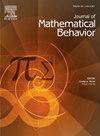是什么让数学题易于解决且清晰明了?职前教师两步问题提出分析
IF 1.7
Q3 EDUCATION & EDUCATIONAL RESEARCH
引用次数: 0
摘要
能够解决文字问题需要理解和技能,以解决不同但相互关联的数学,语言和上下文特征之间复杂的相互作用。由于在解决过程中需要多个步骤,单词问题的复杂性增加了,学生们面临着额外的挑战。将问题提出有效地融入到数学课程和教学中,需要为教师和职前教师提供全面的问题提出指导。为此,作者采用了各种问题提出任务和策略来支持职前教师。作者分析了56个问题样本,这些问题是由参加问题解决课程的职前教师提出的。这些发现阐明了两步字谜的数学和语言特征,以理解是什么导致了清晰、可解决的字谜问题。影响包括资源,以通知课程的发展,评估,以及未来的研究方向,在两步字题的复杂性。本文章由计算机程序翻译,如有差异,请以英文原文为准。
What makes a math word problem solvable and clear? An analysis of pre-service teachers' two-step problem posing
Being able to solve word problems requires understanding and skills to address the complex interaction between distinct yet interrelated mathematical, linguistic, and contextual features. As word problems increase in complexity by requiring multiple steps in the solution process, students are faced with additional challenges. Effective integration of problem posing into mathematics curricula and instruction requires providing teachers and preservice teachers with comprehensive problem posing instruction. To this end, the authors have employed a variety of problem posing tasks and strategies to support pre-service teachers. The authors analyze 56 samples of problems posed by preservice teachers enrolled in a problem solving course. The findings illuminate the mathematical and linguistic features of two-step word problems to understand what makes for clear, solvable word problems. Implications include resources to inform curricular development, assessment, as well as future research directions in the complexities of two-step word problems.
求助全文
通过发布文献求助,成功后即可免费获取论文全文。
去求助
来源期刊

Journal of Mathematical Behavior
EDUCATION & EDUCATIONAL RESEARCH-
CiteScore
2.70
自引率
17.60%
发文量
69
期刊介绍:
The Journal of Mathematical Behavior solicits original research on the learning and teaching of mathematics. We are interested especially in basic research, research that aims to clarify, in detail and depth, how mathematical ideas develop in learners. Over three decades, our experience confirms a founding premise of this journal: that mathematical thinking, hence mathematics learning as a social enterprise, is special. It is special because mathematics is special, both logically and psychologically. Logically, through the way that mathematical ideas and methods have been built, refined and organized for centuries across a range of cultures; and psychologically, through the variety of ways people today, in many walks of life, make sense of mathematics, develop it, make it their own.
 求助内容:
求助内容: 应助结果提醒方式:
应助结果提醒方式:


